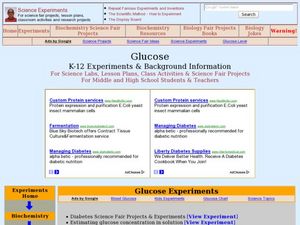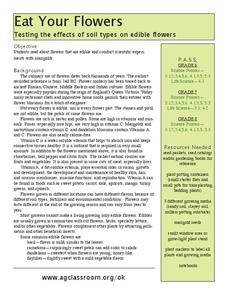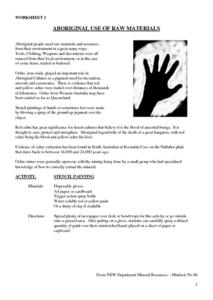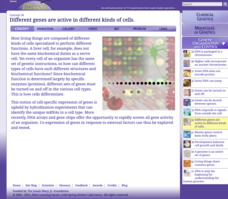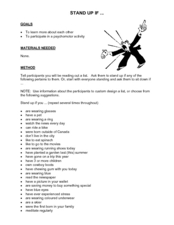Curated OER
Glucose
Learners conduct various experiments on glucose. In this biology instructional activity, students differentiate the process of diffusion and osmosis. They test different foods for the presence of glucose and starch.
Curated OER
Obesity
Young scholars examine how hormones affect different tissues. In groups, they make their own hormone-receptor model and identify the characteristics of tissues that respond to the different hormones. To end the lesson plan, they examine...
Curated OER
Eat Your Flowers
Students grow flowers in different soil mediums to determine the effect on flavor. In this investigative lesson students study flowers, plant them and taste them to see how they differ in different potting soils.
Curated OER
Vital Vitamins
Students study vitamins and who should take them and what ones to take. In this investigative instructional activity students plan a healthy diet after reviewing the types of supplements.
ProCon
Vegetarianism
What do Mike Tyson, Ellen DeGeneres, and Paul McCartney have in common? They're all famous vegetarians. Using the resource, scholars learn about the pros and cons of eating a vegetarian diet. They read a fascinating history of...
NSW Department Mineral Resources
Aboriginal Use of Raw Materials
What's the difference between base metals and precious metals? Experimenting with natural metals is an interesting way for kids to learn about the world around them. Use a resource that contains over 30 pages of worksheets and...
K12 Reader
Tissues, Organs and Systems
Young scientists are introduced to the connections among cells, tissues, organs, and systems in a life science reading comprehension worksheet that asks them to respond to a series of questions based on the passage.
Cold Spring Harbor Laboratory
Different Genes Are Active in Different Kinds of Cells
Personalized medicine prevents many trial-and-error scenarios when time counts the most. Learn how gene expression and screening genomes improves health outcomes in cancer patients, those with auto-immune disorders, and more. An online...
Curated OER
Lungs: The Breathing Machine
Students create a model of the lungs and diaphragm. In this breathing activity, students create a model out of a plastic bottle and balloons. They see how the diaphragm helps to fill the lungs with air.
Curated OER
DNA Activities
Students work together to identify the structure of DNA. They practice using new vocabulary as well. They create a 3-D model of DNA to complete the lesson.
Curated OER
Health Benefits of Rice
Sixth graders examine the health benefits of rice. In this food benefits instructional activity, 6th graders discover the nutritious benefits of rice. Students research Celiac Sprue disease and how rice benefits the people with this...
Curated OER
The Three Worm Phyla
Ninth graders examine the three worm phyla. In this classification lesson, 9th graders observe, compare and contrast the planarian, tapeworm, and fluke.
Curated OER
Enzymes
Tenth graders test their saliva for enzyme activity. In this enzyme lesson, 10th graders conduct an experiment to test the enzymatic activity of their saliva. They relate the lack of certain digestive enzymes with alcoholism.
Curated OER
Malnourishment and Poverty
Young scholars discover how poverty impacts people in many developing countries. In this Student Voices against Poverty lesson, students calculate data on numbers of children suffering from Vitamin A deficiency and numbers of people...
Curated OER
Viruses
In this biology lesson, students complete a crossword puzzle with 35 questions about viruses. They identify the different types of viruses and the diseases they bring.
Curated OER
Organs and What They Do - Lecture
Students read information about the internal organs and body systems. In this organs and systems lesson, students read descriptions of the heart, lungs, stomach, small and large intestine, and liver and gall bladder. Students study...
Curated OER
Science: Lead Shot and Waterfowl
Students examine data to investigate the impact of lead shot pellets on waterfowl populations. They graph their findings and discover how lead in ingested by birds and poisons them. As an extension, students research legislation and...
Curated OER
Organs to Go...
Students explain the principles of experimental design and reinforce the steps of the scientific method. Each group of students create a "slush" type mixture to store a chicken liver.
Curated OER
Cells and Cancer
Students idenitfy that cancer is a growth of mutated cells and that cancer cells are only one type of cell that causes disease in our body. They also identify that all eukaryotic cells contain a nucleus, cytoskeleton, and a cell...
Curated OER
Traditional Food in the United Kingdom
Students read an article that discusses numerous food traditions. In this ESL activity, students work in small groups to complete a vocabulary assignment on the article, a brainstorming activity, writing an essay and a grammar assignment.
Curated OER
Stand Uo If....
Pupils participate in an activity that allows them to better get to know each other. In this inquiry lesson students use a psychomotor activity to better know their classmates.
Curated OER
From One End to the Other
Seventh graders trace a piece of food through the alimentary canal and differentiate between mechanical and chemical digestion in several different hands-on activities related to digestion.
Curated OER
From One End to the Other
Seventh graders become more familiar with how our food is broken down mechanically and chemically. They also trace the food through the alimentary canal.
Curated OER
Do You Have the Guts?
Seventh graders Name and locate the major internal organs of the human body and the frog. Students virtually dissect a frog and compare organs to the human organs. Students draw illustrations of their learnings.


